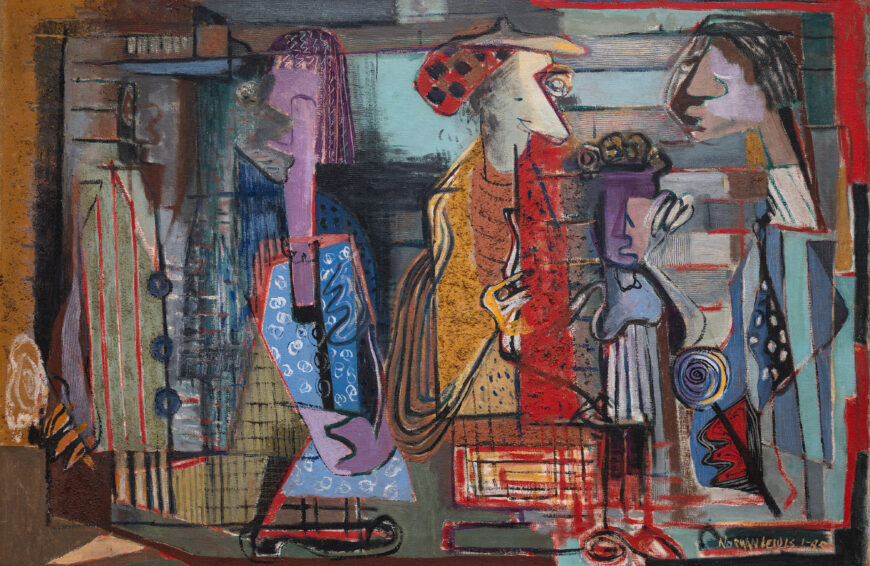George Bellows, Pennsylvania Station Excavation, c. 1907–08, oil on canvas, 79.2 x 97.1 cm (Brooklyn Museum), a Seeing America video Speakers: Dr. Margarita Karasoulas, Assistant Curator, American Art, Brooklyn Museum and Dr. Steven Zucker
[0:00] [music]
Dr. Steven Zucker: [0:05] We’re in the Brooklyn Museum, looking at a painting by George Bellows, “Pennsylvania Station Excavation.” What we’re looking at is a large hole in the earth in Manhattan, and this was being excavated in preparation for the building of Pennsylvania Station.
Dr. Margarita Karasoulas: [0:22] Pennsylvania Station took up eight acres of city space, two city blocks from 31st to 33rd Street and from 7th to 8th Avenues.
Dr. Zucker: [0:31] It’s useful to locate this incredibly ambitious project at a moment when this great American city is rising up. Skyscrapers are being built around the city. There’s a scale of ambition here that is unprecedented.
Dr. Karasoulas: [0:45] And nowhere was that transformation more evident than in the changes that were made to the urban transportation systems during this era, beginning with the construction of the elevated railways in the 1870s, the advent of streetcars in the 1890s, and then the completion of the subway system in 1904.
Dr. Zucker: [1:01] This project was being undertaken by a man named Cassatt, who actually is, interestingly, the older brother of Mary Cassatt, the American Impressionist. The brother had a problem. He was the president of one of the wealthiest and most powerful railroads in the United States, that controlled much of the rail between Chicago and New York.
[1:19] The problem was that the train stopped in Jersey City. He needed to figure out a way to get his trains into what had become the premier city of the United States.
Dr. Karasoulas: [1:29] In fact, at that time, commuters were taking ferries to get from New Jersey to New York City. So this was a big challenge for them to figure out a way to construct underground tunnels under the Hudson River and to construct this new railway station in Midtown Manhattan, which became transformed not only as the center of the city’s transportation district but also its retail and entertainment districts.
Dr. Zucker: [1:52] But this painting is so unexpected, because instead of seeing the triumph of the skyscrapers of New York, the triumph of technology, we’re looking at this bleak, dirty pit in the earth.
Dr. Karasoulas: [2:04] Bellows was really interested in conveying the underside of the city’s progress during this period. He’s using vigorous, raw, slashing brushwork to convey the snow and the details in the scene. It has a very dirty and gritty quality, and that’s reflected in the bonfires that we see here in the center of the composition, in this acidic, garishly-colored sky that’s illuminated by bits of yellow and gold, and most of all by these billowing plumes of steam and smoke that rise out of this gaping pit in the earth.
Dr. Zucker: [2:36] If I think about historical precedents, I start thinking about the engravings of Piranesi, or images that were representing hell coming out of Dante. Bellows has created a kind of man-made canyon.
Dr. Karasoulas: [2:50] Bellows has very deliberately employed this elevated vantage point and included these four workers who are perched on the margins of this composition. By employing that elevated vantage point, he also emphasizes this gaping pit in the earth.
Dr. Zucker: [3:05] It’s so interesting, now that we know what rose in this place, this beautiful Beaux Arts structure, this structure was recalling the rationalism and beauty of the classical tradition.
Dr. Karasoulas: [3:16] McKim, Mead & White designed the Beaux Arts structure of Pennsylvania Station. It’s the same architectural firm that designed the Brooklyn Museum.
Dr. Zucker: [3:23] Right in the middle of the pit, we can see rising up, almost like the mast of a ship, the cranes of steam shovels that were used in this demolition.
Dr. Karasoulas: [3:31] Bellows worked from memory, but we also know that he was very much inspired by the images that proliferated in the mass media during this moment, the many photographs and also literary accounts that talked about the construction of the site.
Dr. Zucker: [3:44] New Yorkers were waiting in anticipation for the building that would rise out of this massive project. This area had been densely populated. This was not open space.
Dr. Karasoulas: [3:54] This area of the city was known as the Tenderloin, which is now modern-day Chelsea. It was populated by an African American community, thousands of which were displaced for the construction of Pennsylvania Station.
Dr. Zucker: [4:07] What we’re seeing is the pit where the station itself would be located, but slightly to the west of this the excavation continued, and only in the last few years in New York have we built over that, an area that’s called Hudson Yards.
[4:21] What we’re seeing is the preparation for the building of one of the most magnificent, one of the most architecturally significant buildings in New York City, Pennsylvania Station, but it’s not a building that survived.
Dr. Karasoulas: [4:31] Unfortunately, in 1963, this wonderful railway station was demolished to make way for what is now Madison Square Garden and the current Pennsylvania Station.
Dr. Zucker: [4:41] The demolition of Pennsylvania Station helped to rally support for an effort that was already underway to create the Landmarks Preservation Commission, part of New York City government.
Dr. Karasoulas: [4:51] I find these kinds of paintings to be a commentary on changing New York, on old versus new New York.
[4:57] In a way, I see how this painting even anticipates Berenice Abbot’s “Changing New York,” her photographic series from 1935, and here I think that Bellows is offering a commentary on the underside of the city’s progress and on the challenges of modernity.
[5:12] [music]












